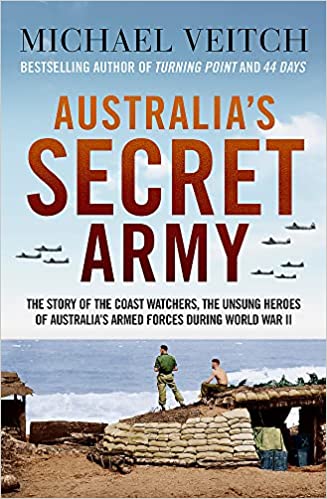
Australia’s Secret Army. By Michael Vietch. Sydney: Hatchette, 2022.
Reviewed by Tom Lewis
On seeing this new work – Australia’s Secret Army – two immediate thoughts came to mind. The first was that the title may be misleading: Australia’s Coastwatchers of World War II were all in the Navy. The second was why replace the classic book The Coast Watchers – written by the man who organised them and operated them – with this? But those thoughts aside, this is a worthy addition to one of the greatest stories of the Pacific theatre in World War II.
The Coastwatchers were the brainchild of Eric Feldt. A naval officer of the class of 1913 – the immortal first intake of the embryo Naval College of the fledgling Royal Australia Navy – Feldt left the Navy after the Great War, somewhat disillusioned with his chances in the force. He worked in New Guinea commercially, but in the early stages of World War II, like so many, he returned to the Colours. The Allied cause in the Pacific would be grateful he did. Armed with little more than radios, a uniform to distinguish them as combatants rather than spies, and a great deal of bravery, they were a clandestine organisation of intelligence providers scattered across former colonial outposts and the like throughout the Pacific to the north of Australia.
In later noting the vital role played by the Coastwatchers with their timely warnings of enemy bombers headed towards Guadalcanal, the United States Admiral “Bull” Halsey said ‘The Coastwatchers saved Guadalcanal, and Guadalcanal saved the South Pacific.’ The Coastwatchers’ signals were crucial. The warning precipitated the May 1942 Battle of the Coral Sea, which prevented the Japanese invasion of Port Moresby. In a foreword to the Feldt’s book The Coast Watchers, ‘Weary’ Dunlop, the great Prisoner of War and surgeon, wrote in 1991 “It could equally be said that the Coast Watchers saved Port Moresby and Port Moresby saved Australia”. Feldt’s book is well out of print now, so Australia’s Secret Army, showing today’s generations the essential work of these brave men, is welcome.
The book is well researched in general, unlike what is often said about the Coastwatchers. The stories of the organisation that one often reads online and so on though are littered with legend and often errors. The organisation was not formed until the end of 1942, so erroneously one can sometimes read of supposed members who were working before that. One well-known presumed Coastwatcher was John Gribble, who is sometimes claimed to have given a warning of the massive Japanese air raid which was launched from four air aircraft carriers and attacked Darwin on 19 February 1942. It passed over the top of the Tiwi Islands, although Gribble, as he advised later, was well-away from his radio and passed on no such advice, unlike Father John McGrath, whose radioed warning of an unusually large number of aircraft was confused with approaching American machines.
This new book spares us such furphies, but occasionally lapses into misinformation. For example, “So terrible were the details of the massacre at Tol, and similar ones at nearby Waitavolo and Karlai, the Australian government suppressed the details for decades.” Instead, such details came out in the war crimes trials in 1946-1947, and the results of the trials were widely reported in the newspapers.
Also somewhat annoying are the occasional generalisations. For example, concerning the US Marines: “men prayed in a constant, murmuring supplication, let me die anywhere, but not here,” and the Coastwatchers are said to have assumed “a mystical status: somewhere out in that wilderness toiled an unseen army of brave men”. Both are sweeping statements, and without proof of them, how can such thoughts be assigned to thousands of men?
In general however the work follows the story chronologically, concentrating on the major achievements and the background detail of the organisation: their radio sets – heavy and cumbersome but essential; the recruiting and organisation of the individuals, and the occasional disasters such as capture or the Japanese negating the abilities of the behind-the-scenes spies.
Although Australia’s Secret Army would have benefitted from illustrations – it only has a single map – it is a worthwhile read.



